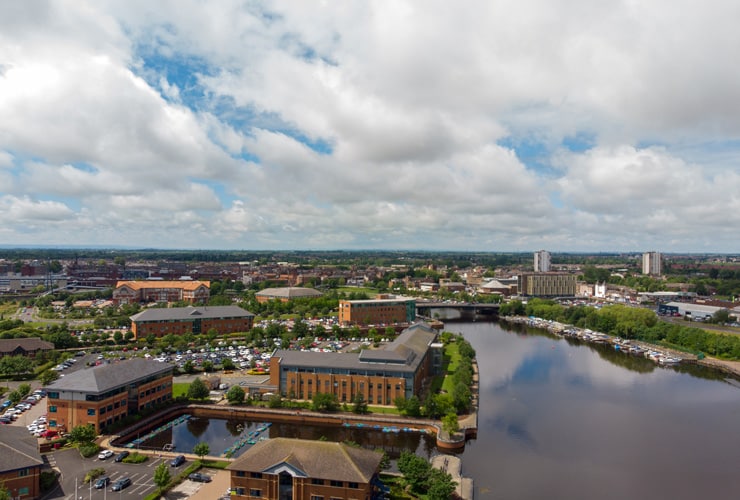Areas of Middlesbrough: Buy-to-Let Property Investment Hotspots
Middlesbrough, Teesside, often gets a bad press. It’s a town that has suffered from more than its fair share of industrial decline in the past. But Middlesbrough has ambitious plans to renew, regenerate and rebuild for the future. Right now, property prices are still low. So could now be the perfect time for property investors to jump in?
Contents
Why Invest in Middlesbrough?
Middlesbrough, known locally as Boro, is the largest town in the North of England and one of the fastest-growing towns in the UK. With a population of over 130,000, Middlesbrough is a major industrial centre and has a strong heritage in heavy industry, particularly steelmaking and chemicals. While the closure of the Teesside Steelworks in 2015 had a significant impact on the local economy, Middlesbrough is now focused on regeneration and attracting new industries.
The South Tees Development Corporation (STDC) has ambitious plans to redevelop the former steelworks site into a world-class industrial park, to attract £10 billion of investment and create 20,000 new jobs over 20 years. The area has been designated a Special Economic Area, and there are proposals to establish it as a free port.
The chemical industry remains a key sector in Middlesbrough, with the Wilton International site being one of the UK's most prominent centres for chemical manufacturing. Teesdale Business Park is home to several large national companies, providing hundreds of jobs.
There is a strong drive to attract new industries to the Teesside area, including healthcare, life sciences, digital and creative technologies, professional services, and energy and renewables. The Tees Valley Enterprise Zone is successfully drawing new businesses and creating employment opportunities. TeesAMP, a £55 million development, will establish a new business park for advanced manufacturing companies, with the potential to generate 1,000 high-quality jobs.
Middlesbrough is also experiencing a digital revolution, with the Middlehaven area, located near the town's historic centre, becoming a hub for technology innovation and digital industries. The council's long-term regeneration plans for this area include the creation of an urban farm and Boho X, a 60,000-square-foot centre for the town's burgeoning digital sector.
Teesside University, located in the heart of Middlesbrough, is an integral part of the town's appeal to investors. With approximately 19,000 students and a £270 million investment in its campus, the university has ambitious growth plans. It has recently improved its facilities, including the library, sports amenities, and laboratories, and is committed to enhancing the student experience and supporting local businesses.
The Tees Valley Combined Authority, led by Mayor Ben Houchen, has a Ten-Year Investment Plan to revitalise the area, improve transport links, attract new industries, and create jobs. This includes major investments totalling £500 million, which have already generated 4,000 new jobs, supported businesses, expanded educational facilities, and constructed 7,000 new homes.
With its diverse economy, regeneration projects, and the presence of a thriving university, Middlesbrough presents an attractive opportunity for investors. The town's low property prices, high rental yields, and potential for future growth make it a compelling prospect for those seeking to capitalise on its exciting prospects.

Amenities
Teesport, located at the mouth of the River Tees, is a major deep-sea port and the third largest in the UK. It handles over 56 million tonnes of cargo a year and supports steel, petrochemical, manufacturing, engineering, and retail operations. There are plans to expand the port by building a huge new Northern Gateway container terminal.
Middlesbrough railway station is the fourth busiest in North East England and offers services to Newcastle, Sunderland, Darlington, Redcar Central, Whitby, Leeds, York, Manchester, and London Kings Cross. Teesside International Airport is located in North Yorkshire about 11 miles from Middlesbrough town centre. The airport connects with the rest of the UK and with Europe.
Although Teesside is an urban area, offering shops, services, entertainment, and leisure facilities, it is also close to the countryside and beaches. The town is approximately six miles from the coast, seven miles from Roseberry Topping in the North York Moors National Park, and 25 miles from the Yorkshire Dales National Park. Saltburn-by-the-Sea, a popular seaside destination with a shingle and sandy beach, is just a 20-minute drive from Middlesbrough.

Property Values
House prices in Middlesbrough are some of the lowest in the UK. The average house price in Middlesbrough was £129,000 in March 2024, according to the Office for National Statistics and HM Land Registry. This was a decrease of 8% from March 2023. According to Zoopla, as of March 2024, the average sold price for a property in Middlesbrough over the last 12 months has been £116,140, while Varbes say that the average property price is currently £154,930.
Property prices vary across Teesside, with prices ranging from under £50,000 up to £450,000. The most common price band for property sales in Middlesbrough is £50,000–£100,000, which accounted for 19.9% of properties sold in the 2023 calendar year.
The average price for a house in Middlesbrough ranges from £96,554 for a terraced house to £282,262 for a detached house, with semi-detached houses in between, costing on average £160,623. The average price for a flat or maisonette in Middlesbrough is £80,398.
Middlesbrough Council is currently working on several regeneration projects, including a £34 million overhaul of Middlesbrough Railway Station, the development of a new secondary school, and the creation of an urban farm and community garden by the Camphill Village Trust. The council has also welcomed a £14.1 million allocation from the Future High Streets Fund, which will help boost the town's population and create a regional leisure hub.
Average Asking Price by Postcode Area
Last updated: August 2024
Data from propertydata.co.uk
| Postcode District | Average Asking Price |
|---|---|
| TS1 | £95,429 |
| TS3 | £94,268 |
| TS4 | £121,451 |
| TS5 | £175,444 |
| TS6 | £160,661 |
| TS7 | £256,029 |
| TS8 | £198,090 |
| TS9 | £347,834 |
Rental Demand
Rental demand in Middlesbrough is strong, with the town offering some of the highest rental yields in the UK. The average rent in Middlesbrough, according to Varbes is around £538, which is £456 lower than the £994 average in England. According to the ONS, the average rent in Middlesbrough rose to £591 in March 2024, an annual increase of 7.6%.
The average gross rental yield in Middlesbrough is 8.52%, with the TS1 postcode area offering 7.3% and the TS3 postcode area offering 8.9%. The average gross rental yield in the UK is currently 5.6%, according to Zoopla.
The North East, which includes Middlesbrough, is the second-highest region for average gross rental yield at 5.18%, with Scotland in first place at 6.18%. The North East also has the lowest average monthly rent in the UK at £662, and the lowest average cost of a buy-to-let property at £109,072.
The high rental yields in Middlesbrough are due to strong rental demand and reasonably priced properties. The town has a large student population and is attracting young professionals, contributing to the demand for rental properties.
Average Rental Yield by Postcode Area
Rental yield is the rental return an investor can expect on their investment once costs have been taken into consideration.
Last updated: August 2024
Data from propertydata.co.uk
| Postcode District | Average Rental Yield |
|---|---|
| TS1 | 6.8% |
| TS3 | 8.5% |
| TS4 | 6.2% |
| TS5 | 5.3% |
| TS6 | 5.1% |

The Best Places to Live in Middlesbrough
Middlesbrough offers a range of desirable locations to suit different preferences and budgets. Here are some of the best areas to live in and around the town:
- Linthorpe: Located south of the town centre, Linthorpe is known for its elegant Victorian and Edwardian homes. It offers a mix of traditional terraces, as seen on Oliver Street and Haymore Street, along with larger semi-detached and detached properties on streets like Claude Avenue and Cambridge Road.
- Acklam: Acklam is ideal for those seeking traditional semi-detached and detached homes with bay windows. Stoneleigh Avenue and Highbury Avenue are prime examples of this style. For a touch of 20th-century design, Cowley Road features Arts & Crafts-style homes.
- Marton-in-Cleveland: This area boasts eye-catching detached and semi-detached properties with generous gardens. The Grove is one of the most desirable roads, offering a peaceful setting alongside impressive homes.
- Nunthorpe: Nunthorpe is the place to find imposing and expensive properties. Character detached homes with five or more bedrooms can be found on Guisborough Road, while Connaught Road features period semis set back from the road. For new-build options, consider the detached and semi-detached homes in Nunthorpe Gardens.
- Cargo Fleet: This area is popular among students, offering convenient access to Teesside University.
- Town Centre: The town centre is characterised by humble Victorian terraces. Falmouth Street and Worcester Street feature flat-fronted terraces, while Beaumont Road and Crescent Road showcase houses with attractive bay windows.
- South Bank: South Bank is a family-friendly area with good amenities and a sense of community.
- Hemlington: Hemlington is another family-oriented neighbourhood, offering a mix of housing options and a strong sense of community.
- Primrose Hill: Primrose Hill is a sought-after area known for its charming homes and convenient location.
- Eston, Normanby, Old Lackenby, Ormesby, and Thornaby: These areas are popular among students due to their proximity to Teesside University and convenient access to campus.
- Guisborough: Guisborough is a charming market town with a cobbled high street. It offers new housing developments, such as the Pine Walk development, featuring a mix of terraced, semi-detached, and detached homes with modern designs and open-plan living spaces.
- Newton Aycliffe: Newton Aycliffe presents another opportunity for contemporary living with The Woodlands development, offering two-, three-, and four-bedroom homes, including terraces with gardens and larger detached houses with internal garages.
Property Investment in Middlesbrough
As well as Middlesbrough itself Teesside comprises four other boroughs all of which offer opportunities for property investors. Here’s our handy guide to property investment in and around Middlesbrough:
Middlesbrough
Population: 138,400
Average House Price: £129,000
Although there are regeneration plans in progress some inner districts of Middlesbrough suffer from a high level of deprivation. Investors can find some of the area’s cheapest properties here. The outer suburbs of Middlesbrough are popular residential areas good for family buy-to-let – for example, Acklam, Marton and Nunthorpe.
Middlesbrough postcodes are TS1 to TS7 inclusive. Some of the best yields in the UK are to be had in TS1 at 7.3% and TS3 at 8.9%.
Darlington
Population: 105,00
Average House Price: £130,666
The separate market town of Darlington – or Darlo as it’s known – is in County Durham, 9 miles west of Middlesbrough. It has good local amenities, is right on the A1(M) and Darlington Station has direct trains to London, Newcastle and Edinburgh.
Within Darlington DL1 offers attractive yields of 5.3% while DL2 offers 4.6%.
Hartlepool
Population: 92,000
Average House Price: £109,458
The coastal town of Hartlepool is 7 miles north of Middlesbrough. Hartlepool has also suffered from industrial decline in the past, so is a cheap property location. However, Hartlepool has a number of successful local industries. Tourist and leisure attractions include Hartlepool Marina and the National Museum of the Royal Navy.
Yields here, based on TS24, TS25, TS26 and TS27 postcodes can be up to 5%.
Redcar and Cleveland
Population: 136,000
Average House Price: £120,974
The Borough of Redcar and Cleveland is a diverse area. It includes the Wilton International chemicals site which is an important employer, the coastal towns of Redcar and Saltburn by the Sea, the market town of Guisborough and a number of rural villages. There’s good value investment property to be had here although there are a number of pricier commuter spots too.
Yields here, based on TS10 to TS14 postcodes inclusive, are around 4%.
Stockton on Tees
Population: 85,000
Average House Price: £138,641
Stockton on Tees in County Durham borders Middlesbrough but is a separate large town. It incorporates smaller towns such as Thornaby on Tees and Billingham. Stockton, as it’s known, is generally a low price property area although areas in the southern part of the borough like Eaglescliffe and Yarm are pricier commuter spots. Ingleby Barwick is a large new village developed over the last 30 years and popular with buy to let investors.
Yields here are at least 4% generally but in TS20 and TS21 5% should be possible.
